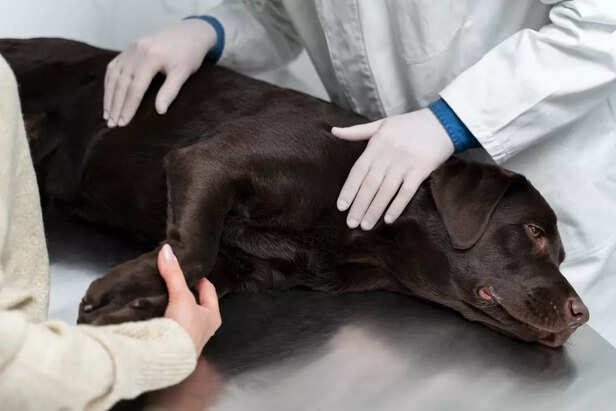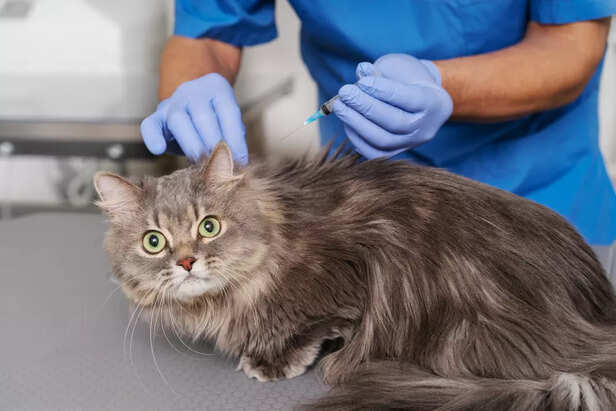1. Lipoma (Fatty Tumor)

Pet and veterinarian
( Image credit : Freepik )
Lipomas are the most common benign skin tumors of dogs, which are most frequently found in middle-aged and overweight animals. The small, soft, movable lumps that originate below the skin usually grow slowly with time. Typically, they do not cause any discomfort and are safe; however, these tumors can reach a size that can interfere with the animal's movement or rest. The occurrence of lipomas is more frequent in Labrador Retrievers and Dobermans. The therapy is not necessarily required, but if the mass gets larger, imparts pain, or restricts movement, then surgery may be recommended.
2. Mast Cell Tumor (MCT)
Mast Cell Tumors (MCTs) belong to the most aggressive skin cancers in canine and feline cases, though rarely in cats. The main characteristic of mast cell tumors lies in the fact that these are purposed cells (mast cells) that actively partake in allergy reactions; hence, the tumors may look like red, swollen, or ulcerated bumps that rapidly change their sizes. To the greatest extent, these neoplasms occur in such dog breeds as Boxers, Pugs, and Bulldogs. MCTs, being able to metastasize to other organs, make the diagnosis at an early stage of the disease very important. Normally, the first step of the treatment is surgery with wide margins, followed by chemotherapy or radiotherapy in case of more aggressive tumors.
3. Sebaceous Adenoma

Pet and veterinarian
( Image credit : Freepik )
Sebaceous adenomas are non-cancerous tumors that develop from the sebaceous glands of the skin. The lesions are typical for geriatric dogs and are recognizable as small, warty growths that might release a scaly or oily matter. Though generally benign, the tumors have the potential to be irritated or infected in case they are scratched or licked a lot. When they turn into a source of trouble, surgery is the treatment of choice; however, in the majority of cases, just their size and status can be used for the management.
4. Melanoma
Melanomas are pigment cell cancers called melanocytes, comprising both benign and malignant. In dogs, they are usually localized in the mouth, lips, or toes, and in cats, the skin and eyes may be affected. The tumors are generally black or dark brown and in the course of their development may also bleed or ulcerate. Surgery is often enough for the removal of benign melanomas, while malignant ones need to be treated with immunotherapy, radiation, or chemotherapy as well. Early diagnosis of these tumors can be made by frequent examination of your pet’s skin for any dark spots or moles.
5. Squamous Cell Carcinoma (SCC)

Dog
( Image credit : Unsplash )
Squamous cell carcinoma is a cancer of the skin that starts with the excessive exposure of the skin to the sun. Light-colored or hairless animals with exposed skin in areas such as the nose, ears, or eyelids are the ones usually affected by it. The disease is often found in white cats and such dog breeds as Dalmatians or Bull Terriers. SCC may at first develop as crusty, scabby, or non-healing sores that can be accompanied by bleeding or infection. The removal of the tumor by early surgery is the most favorable outcome, though in some cases, it may be necessary to take radiation therapy. In which pets that are left under the sun for long hours are the ones prone to getting SCC.
6. Histiocytoma
Histiocytomas are benign tumors, which are most frequent in young dogs under three years of age. These are immune cell-related tumors and usually appear as small, red, hairless bumps, which are localized most often on the head, ears, or legs. These bumps, at most, can scare the owner, but they are in fact safe and quite often disappear spontaneously in a few months. In case of infection, rapid growth, or the tumor causing the animal’s distress, the doctor may then suggest its removal by surgery. Since such bumps can be similar to malignant tumors, an appropriate step would be taking them to a vet for examination.
7. Fibrosarcoma

Dog
( Image credit : Pexels )
Fibrosarcomas are violent cancerous growths that derive from fibrous connective tissues that are under the skin. Their incidence is much higher in cats as compared to dogs, and these are often linked to vaccination areas; thus, the term “injection-site sarcoma” is used. These tumors move in a slow manner, but they still extend deeply into the neighboring tissue, which makes them hard to be removed by surgery. They generally exhibit a solid consistency and can be perceived as being connected to the muscles underneath. The treatment that is most likely to be prescribed is a combination of a wide surgical excision and then radiation therapy to lower the chances of recurrence. The process of early diagnosis greatly enhances the prognosis.
8. Basal Cell Tumor
Basal cell tumors are from the skin's basal layer and are significantly more prevalent in aged cats as compared to dogs. Typically, they present as solid, elevated bumps that, if rubbed, may become ulcerated or bleed. The majority of basal cell tumors are non-cancerous, but a small portion can transition to cancer. Surgery to remove them is mostly a treatment procedure, and the chances of relapse are minimal. Such neoplasms include the areas of the head, neck, or shoulders, and the correct treatment followed via interaction with the vet before any trouble ensures timely administration.
9. Papilloma (Wart)

Cats
( Image credit : Pexels )
Papillomas, or warts as people commonly refer to them, are a papillomavirus infection that is usually found in young or immunocompromised dogs. The result of the infection is small, cauliflower-like growths in the areas of the mouth, lips, eyes, or paws. Papillomas can be transmitted from one dog to another; however, they are not transferable to humans or cats. A majority of the warts heal by themselves within several weeks or months when the immune system gets rid of the virus. Though, as an exception, there are cases when infected or stubborn papillomas are to be removed by surgery or cryotherapy.
10. Hemangioma and Hemangiosarcoma
Hemangiomas and hemangiosarcomas are tumors deriving from the cells of blood vessels. The first group are benign and generally manifest as dark red or purple nodules on the skin, which are, most of the time, the result of sun exposure. Hemangiosarcomas, however, are cancerous and may originate inside the body in the spleen, liver, or heart. Such tumors are very dangerous and may lead to a sudden internal body hemorrhage. The lumps on the skin that are visible may start to bleed or change their color. The procedure for treatment includes the removal of the affected part through surgery, and in cases of malignancy, chemotherapy is usually given along with it. The regular doctor visits can be instrumental in the early finding of these tumors before they reach a grave stage.
Early Detection and Regular Vet Care: The Key to Protecting Your Pet from Skin Tumors
The development of skin tumors in dogs and cats has become a frequent occurrence, yet not all skin lumps are harmful. There are some growths made of fat that have no danger to the pet going along with others that can be fast-moving cancers requiring emergency rescue. It is still possible that your pet will enjoy a long and good life through careful watching, regular vet visits, and a quick decision when necessary. Don't forget that the combination of an early detection call by the owner and an expert diagnosis is the road to successful treatment.
Celebrate the bond with your pets, explore
Health & Nutrition, discover
Breeds, master
Training Tips,
decode Behavior, and set out on exciting
Travel Tails with
Times Pets!Frequently Asked Questions (FAQs)- What is the most common skin tumor in dogs?
Mast cell tumors - What is the most common skin tumor in cats?
Basal cell tumors, mast cell tumors, squamous cell carcinoma, and fibrosarcoma - What is a rare skin disease in cats?
Discoid lupus erythematosus (DLE) - Where are tumors most common in dogs?
On or just below the skin





